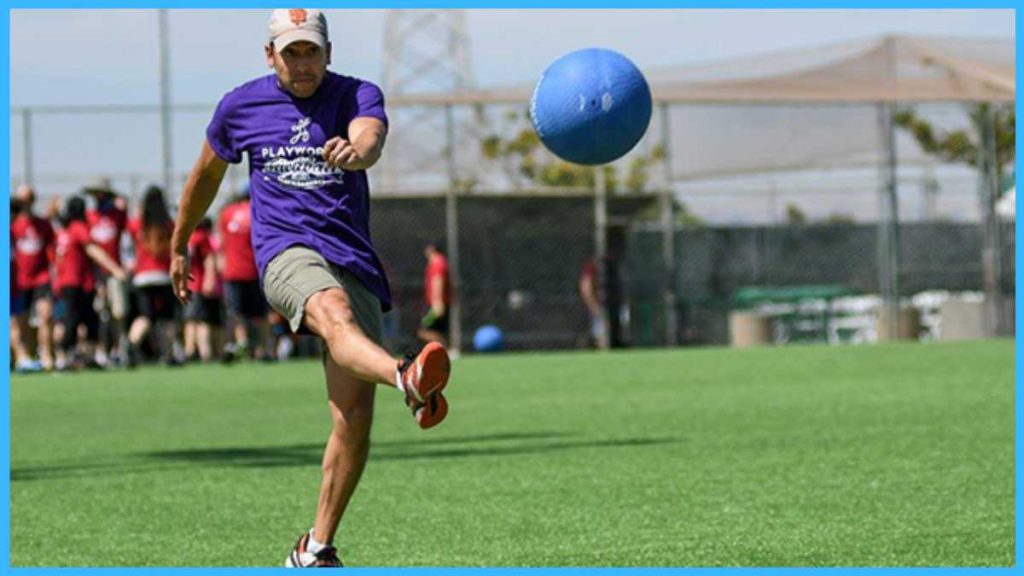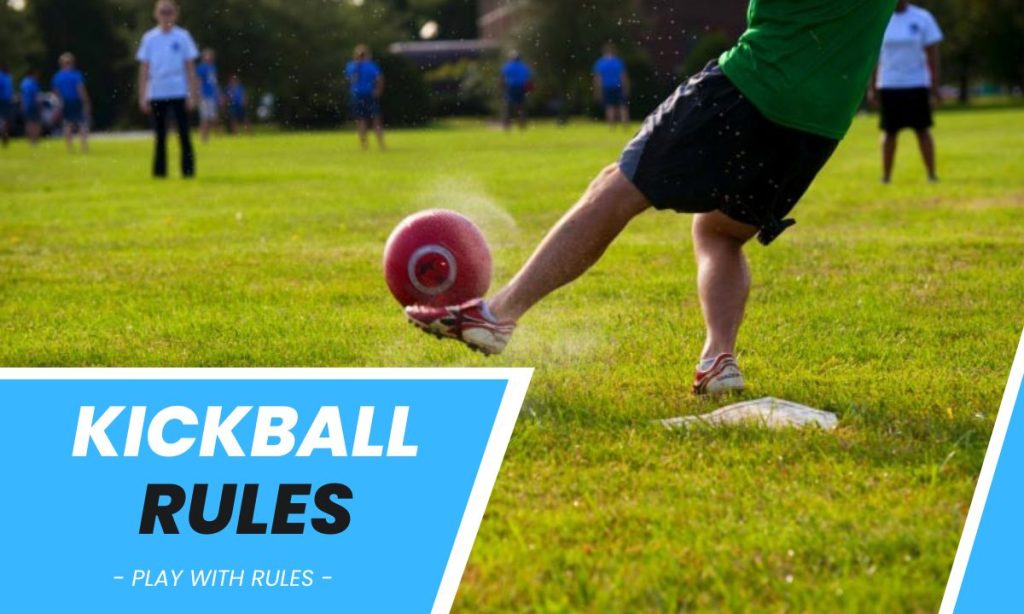Kickball Rules: If you had to, would you be able to pick between football, baseball, and softball? We can’t either! Thankfully, there is a sport that caters to us – a sport that combines the best of football, baseball, and softball. Aptly named, Kickball is basically baseball. But Kickball rules are pretty different. In fact, instead of using bats, players or hitters are supposed to kick the ball into the play area. Also, the ball used in Kickball is bigger than the ball used in baseball. Want to know more about this fun sport and how to play Kickball? Then keep reading!
Table of Contents
What Is Kickball Game?
Kickball (also known as soccer baseball in Canada) is a very popular sport in the United States. The way to play it is quite similar to that of baseball. However, the only differentiating factor for kickball is that you have to kick the ball instead of hitting it with a bat. The red WAKA Logo Kickball is the only recognized ball for the sport.
Originating in school circles in the United States, Kickball was introduced to the students as a part of their Physical Education (P.E.). It wasn’t until later that it became popular among adults as a recreational game. Today, there are standing kickball rules since it has grown into a well-recognized sport across the US, with different leagues under WAKA (World Adult Kickball Association), which is the official governing body for the sport.
Objective
The objective of Kickball is quite simple: score more runs than your opposing team. A team can score runs by kicking the ball and covering as many bases as possible. When not kicking, the objective is to prevent the opponents from covering bases by getting them out, as per the official kickball rules.

Kickball Rules
The rules for a more serious kickball game will obviously be far more stringent than the kickball rules for kids. So, how exactly are you supposed to play Kickball? What are the rules of Kickball? How are you supposed to score points? How can you eliminate the opponent team? Read on to find out:
General
- The rules of kickball state that a maximum of 10 fielders are allowed on the field at a time.
- The game will last 7 innings (if there is enough time for it to go on that long).
- There are 2 base coaches and 3 referees (one for each base).
- A team scores a point when the runner from that team touches all four bases without getting out.
- Contrary to popular belief, “bouncies” (a pitch that bounces across the plate is referred to as a bouncie) are allowed. However, in that case, the ball must bounce twice before reaching the home plate. However, Jimmy Walicek, one of the founders of WAKA, once said that a legal ball needs to be rolled. If it bounces, it is called a ‘ball.’
- Kickball also has a strike zone (like baseball), extending to either side of the home plate and above (by 1 ft. each).
- Headshots are not allowed.
- Forced outs are allowed.
- Ghostmen or Ghost Runners are not allowed (although the rules can be a little more flexible in schools or informal games, as per school kickball rules for kids).
- Defending players cannot get runners or kickers out once they touch a base.
- The teams will exchange positions after three outs. In other words, once three players on the kicking team are out, the defensive team becomes the kicking team, and the kicking team defends.
- After each team has been on the kicking end once (3 outs each team), the innings will be over. However, the game can go on for 7 innings or 6.
This is a summary of all the official kickball rules that need to be adhered to in a formal game.
Note: A) Everything outside the lines between home plate and the first and third bases is considered foul territory.
B) Ghostmen or Ghost Runners are basically imaginary runners that you need to call out before batting. This method is used if any of the teams have fewer players.
These are the general rules of the kickball game. But what are the rules of kickball when it comes to kicking, scoring, or even getting your opponent out? Let’s find out!

Kicking Ball
- All kicks must be made using the foot or the leg, according to the WAKA Kickball rules. If the ball touches the player’s leg or foot below the hip level, it will be considered a kick.
- The planted foot cannot extend beyond the outer edge of the home plate when kicking at the home plate or behind it.
- If the kicker is kicking from within the kicking box, then a portion of his plant foot must be inside the box when kicking the pitched ball.
- If the ball is kicked outside the outfield, it is considered a home run.
Running
- Since headshots are not allowed, if a ball is thrown at the runner above shoulder level, then the runner will be deemed safe and will advance to the next base, per official Kickball rules.
- Runners cannot deviate more than 4 feet from their established path to avoid a tag out.
- In the case of an overthrow, the runner can advance to a maximum of one base.
- Runners cannot pass other runners to touch base. In that case, the passing runner will be considered out.
Strikes
- A count of three strikes will be counted as an out.
- A missed kick where the pitched ball enters the strike zone will be considered a strike.
- A pitch that is not kicked but is also not a ball will be considered a strike if it enters the strike zone per the WAKA Kickball rules.

General Information: Scoring, Players & Bases
Now that you’ve got a grasp what are the rules of kickball, let’s delve further into the intricate details of scoring, players, and bases, enriching our understanding of this exciting game. The way to score is quite simple. The kicker has to try to kick the pitched ball into the field (outfield included) while trying to avoid the opponent fielders. Once kicked, the kicker has to run from the home base and touch the first base before the opponent player on the first base touches the runner with the ball or tags the runner out with the ball.
According to the rules of Kickball, a game can be played between teams consisting of 8 – 11 players, as per WAKA. However, it is likely to be played with teams of 5 – 10 members. At a time, no more than 10 players from a team can be on the field. Further, Kickball is also played on a rectangular blacktop area where outlines are marked with chalk or paint.
Similar to Baseball, there are three (precisely four) bases in Kickball as well.
- Home Plate
- First Base
- Second Base
- Third Base
Kicking the ball farther into the field will reward the runner with more time to cover more bases (second and third base). This will earn the running team points.
How To Get Opponents Out?
Once you are done scoring, you need to know there are four ways to get someone out, and they are as follows:
- Strikeout – If the kicker misses three pitches or is unable to keep the kicked ball from going to foul territory thrice, then he is struck out. The next kicker has to come in and take his place.
- Tag out – This occurs when a player or a fielder from the defending team touches the runner with the ball after kicking the ball and before the runner makes it to the base.
- Forced out – When a defending player on a base obtains the ball before the runner can make it to that base while also being unable to return to the previous base, the runner will be forced out. A runner cannot go back to a base if a teammate is occupying it or if it is the home base.
- Caught out – If the kicker kicks the ball into the air and is caught by a fielder on the opposite team before it touches the ground, the kicker will be caught out.

Understanding The Positions
According to the official kickball rules, the different positions of players in a Kickball game are as follows:
- Pitcher – The pitcher is the player who rolls the ball to the kicker of the opponent team across the home plate.
- Kicker—The kicker is a player who stands at home plate and kicks the ball. S/he also has to run between the different bases.
- Catcher – The catcher stands behind the kicker at the home plate and tries to get the kicker out at the home plate. S/he also passes the ball back to the pitcher.
- Base—There are three bases and a home plate across the field. Each player at the base tries to catch the ball and force the kicking team out, as per the official kickball rules.
- Shortstop – The shortstop stands closer to the kicker than the base players. S/he tries to prevent the ball from bouncing into the outfield. The shortstop also tries to force the kicker out or tag him/her out, per the rules of Kickball.
- The Outfielders – These are players spread across the outfield who are responsible for passing the ball to their teammates if the kicker kicks the ball into the outfield (beyond the players on each of the bases).
Did You Know?
Here are some really exciting facts about Kickball rules that you probably didn’t know of:
- Kickball is played all across the globe. It is called Foot Baseball (Balyagu) in South Korea and Quickbase in Japan. In Canada, they call it California Kickball or Soccer Baseball.
- According to sources, the game Kickball was first invented in 1910 in Dr. Emmett Dunn Angell’s noted book “Play: Comprising Games for the Kindergarten, Playground, Schoolroom, and College: How to Coach and Play Girls’ Basket-ball, Etc.”
- The first official governing body for Kickball (World Adult Kickball Association) was founded in 1998.
FAQs
When I kick the ball, which base do I run to?
After kicking the ball, try to make it to the first base, at least. If you have the time, you can try to cover the second and third base as well.
How many players are allowed to play Kickball?
According to the official kickball rules, each team needs a minimum of 8 players and a maximum of 10 players to play a game of Kickball. However, if you are playing for fun or in school, the players can vary from 5 to 10.
What do I do after making it to the first base?
After reaching the first base, you have to wait for the new kicker to kick the ball and run for the first base. Then, you can continue running.
Why are “bouncies” allowed?
Officially, the ball is to be rolled to the kicker, and it cannot bounce over 1ft. However, this is a kickball rule variation.
Is Bunting allowed in kickball?
The short answer is yes. However, it needs to be done according to the official rules.
Conclusion
Kickball is not just about kicking the ball as far as you can. Sure, it can help win a game for your friends, but you need to follow the kickball rules as well. Further, the idea behind the game is to promote co-ordinate, teamwork, and focus. That is primarily why most schools and colleges across the United States promote the game as a part of the curriculum.
Read More: Have you heard of Lawn Bowling? Well, here is another interesting read for you if you want to learn about Lawn Bowling Rules.

